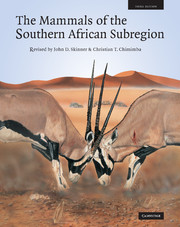Book contents
- Frontmatter
- Contents
- Editorial board
- Acknowledgements
- Foreword
- Preface
- The Mammal Research Institute
- R. H. N. Smithers
- Explanatory notes
- SUPERCOHORT AFROTHERIA
- COHORT PAENUNGULATA
- SUPERCOHORT EUARCHONTAGLIRES COHORT GLIRES
- COHORT EUARCHONTA
- SUPERCOHORT LAURASIATHERIA
- COHORT FERUNGULATA
- Order CARNIVORA
- Order PERISSODACTYLA
- Order SUIFORMES
- Order WHIPPOMORPHA
- Order RUMINANTIA
- Bibliography
- Appendix 1 Conservation status of southern African mammals
- Appendix 2 Colloquial names
- Index of scientific names
- Index of English colloquial names
- List of subscribers
- Plate Section
- Plate Section
- Plate Section
- Plate Section
- Plate Section
- Plate Section
- Plate Section
Order RUMINANTIA
from COHORT FERUNGULATA
Published online by Cambridge University Press: 05 July 2013
- Frontmatter
- Contents
- Editorial board
- Acknowledgements
- Foreword
- Preface
- The Mammal Research Institute
- R. H. N. Smithers
- Explanatory notes
- SUPERCOHORT AFROTHERIA
- COHORT PAENUNGULATA
- SUPERCOHORT EUARCHONTAGLIRES COHORT GLIRES
- COHORT EUARCHONTA
- SUPERCOHORT LAURASIATHERIA
- COHORT FERUNGULATA
- Order CARNIVORA
- Order PERISSODACTYLA
- Order SUIFORMES
- Order WHIPPOMORPHA
- Order RUMINANTIA
- Bibliography
- Appendix 1 Conservation status of southern African mammals
- Appendix 2 Colloquial names
- Index of scientific names
- Index of English colloquial names
- List of subscribers
- Plate Section
- Plate Section
- Plate Section
- Plate Section
- Plate Section
- Plate Section
- Plate Section
Summary
THIS FAMILY IS represented by two living genera and two species: the okapi (Okapia johnstoni) of the lowland forests of East Africa and the Democratic Republic of Congo, and one of the last living African ungulates to be described, and the giraffe (Giraffa camelopardalis), which has a wide distribution in sub-Saharan Africa, although it has been exterminated in many parts of its range through over-exploitation.
The progenitor of modern giraffes, possibly Teruelia, a palaeomerycine, the fossils of which have been recovered from the Teruel basin in Spain, evolved about 25 Mya (Agusti & Moya Sola, 1991). From Teruelia two subfamilies of giraffids, the Climacoceratidae and the Canthumerycidae, arose. The terminal genus of the climacoceratid line was the now extinct massive giraffid Sivatherium sp. The canthumerycids gave rise to okapis and giraffes via the intermediate forms of Giraffokeryx, Palaeotragus sp. (of which the okapi is the extant ‘living fossil’ form – Colbert, 1938), Samotherium sp. and Bohlinia sp., all of which are extinct (Mitchell & Skinner, 2003). The earliest known fossil remains of a giraffine, Canthumeryx sirtense (formerly Zarafa zeltini Hamilton, 1973), were found in Early Miocene deposits in Libya, dated to between 15 and 20 Mya. Canthumeryx, a medium-sized slender antelope about the same size as a fallow deer (Dama dama), possessed the giraffine synapomorphic feature of a bilobed lower canine. From Canthumeryx evolved Giraffokeryx Pilgrim, 1911.
- Type
- Chapter
- Information
- The Mammals of the Southern African Sub-region , pp. 616 - 714Publisher: Cambridge University PressPrint publication year: 2005
- 5
- Cited by

